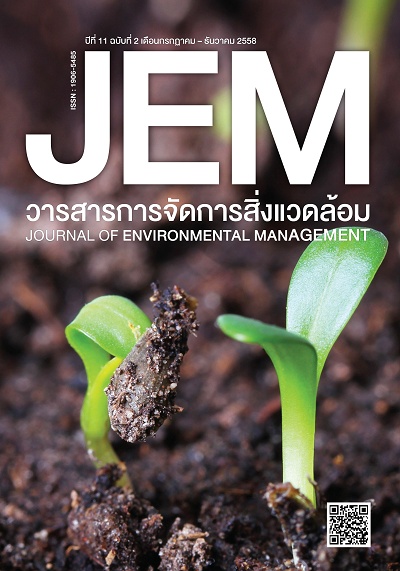การเปลี่ยนแปลงพื้นที่แนวชายฝั่งกับทรัพยากรการท่องเที่ยว: ปัญหา และผลที่ตามมา
DOI:
https://doi.org/10.14456/jem.2015.15บทคัดย่อ
ทรัพยากรการท่องเที่ยวทางชายฝั่งมีความสำคัญต่ออุตสาหกรรมการท่องเที่ยวและเศรษฐกิจของประเทศไทย แต่อย่างไรก็ตาม ทรัพยากรการท่องเที่ยวทางชายฝั่งโดยเฉพาะอย่างยิ่งประเภทชายหาดยังคงได้รับผลกระทบทั้งจากกระบวนการตามธรรมชาติ และจากกิจกรรมของมนุษย์ ชายฝั่งของประเทศไทยมีการเปลี่ยนแปลงทั้งการเปลี่ยนแปลงการใช้ประโยชน์ที่ดินและสิ่งปกคลุมดินการกัดเซาะ และการทับถม ซึ่งการกัดเซาะมีระยะทางรวม 797 กิโลเมตร หรือร้อยละ 27.1 ของความยาวชายฝั่งทะเลทั้งประเทศ อำเภอท่าศาลา จังหวัดนครศรีธรรมราช เป็นพื้นที่หนึ่งที่ได้รับผลกระทบจากการเปลี่ยนแปลงของพื้นที่ชายฝั่งต่อทรัพยากรการท่องเที่ยว ซึ่งส่วนใหญ่จะส่งผลกระทบด้านลบ โดยพบว่าแหล่งท่องเที่ยวประเภทชายหาดถูกกัดเซาะและมีความรุนแรงเพิ่มขึ้นอย่างต่อเนื่อง ชายหาดเปลี่ยนแปลงเป็นพื้นที่น้ำถึงร้อยละ 1.77 ต่อปี ส่วนการทับถมด้วยดินเลน คิดเป็นร้อยละ 0.16 ต่อปี ส่งผลให้พื้นที่เปลี่ยนเป็นหาดเลน ซึ่งส่งผลกระทบโดยตรงต่อธุรกิจร้านอาหาร และที่พัก ต้องปิดกิจการ ส่วนผลกระทบด้านบวกพบว่า ในบางพื้นที่ มีการงอกใหม่ของชายหาด ส่งผลให้มีชายหาดเพื่อการพักผ่อน หย่อนใจและการท่องเที่ยวในพื้นที่เพิ่มขึ้น ปัญหาของการกัดเซาะชายฝั่งยังคงเป็นปัญหาอย่างต่อเนื่อง และมีความรุนแรงเพิ่มมากขึ้น ดังนั้นทุกฝ่ายควรร่วมมือกันในการดำเนินแก้ไขปัญหา และควรมีแผนการปรับตัวและการรับมือกับปัญหาที่เกิดขึ้น
เอกสารอ้างอิง
Cai, F., Su, X., Liu, J., Li, B. & Lei, G. (2009). Coastal erosion in China under the condition of global climate change and measures for its prevention. Progress in Natural Science, 19(4), 415–426.
Chareonsit, P. (2007). Coastal erosion in the monsoon season in the Gulf of Thailand from Chumphon to Pattani between December - January 2007 [In Thai: การสำรวจพื้นที่กัดเซาะชายฝั่งในฤดูมรสุมบริเวณอ่าวไทยฝั่งตะวันตก ตั้งแต่จังหวัดชุมพร ถึงจังหวัดปัตตานี ระหว่างเดือนธันวาคม – มกราคม 2550]. Ministry of Natural Resources and Environment, Bangkok, Thailand, 79 pages.
Cooper, J.A.G. & McKenna, J. (2008). Social justice in coastal erosion management: The temporal and spatial dimensions. Geoforum, 39, 294–306.
Defeo, O., McLachlan, A. Schoeman, D.S. Schlacher, T.A., Dugan, J., Jones, A., Lastra, M. & Scapini, F. (2009). Threats to sandy beach ecosystems: A review. Estuarine, Coastal and Shelf Science, 81(1), 1–12
Department of Environmental Quality Promotion. (2012). Climate Change [In Thai]. Retrieved December 24, 2014, from http://www.environnet.in.th/?p=2771
Department of Marine and Coastal Resources. (2014). Central Database System and Data Standard for Marine and Coastal Resources. [In Thai: ระบบฐานข้อมูลกลางและมาตรฐานข้อมูลทรัพยากรทางทะเลและชายฝั่ง]. Retrieved December 28, 2014, from http://marinegiscenter.dmcr.go.th/km/coastalerosion_doc4/
Department of Tourism. (2014). Tourist Statistics. [In Thai: สถิตินักท่องเที่ยวต่างชาติ]. Retrieved December 18, 2013, from http://tourism.go.th/index.php?mod=WebTourism&file=content&cID=276.
Jarupongsakul, S. (2005). Prioritization of importance and severity area and appropriate resolutions of coastal erosion problems at Pak Phanang river basin, Nahhon Si Thammarat Province [In Thai]. Journal of Metal, Materials and Mineral, 15(1), 11–25.
Kingkeaw, K. (2012). Coastal Erosion and Geo-Informatics. [In Thai: การกัดเซาะชายฝั่งกับเทคโนโลยีภูมิสารสนเทศ]. Final Report, Water Quality Management Bureau, Pollution Control Department, Bangkok, Thailand Marine Knowledge Hub. (2014). Statistic of Tourist in Marine Destination [In Thai: สถิตินักท่องเที่ยวทางทะเล]. Retrieved December 2, 2014, from http://www.mkh.in.th/index.php/2010-03-22-18-05-14/2010-03-26-05-53-09
National Statistical Office. (2014). Tourist Statistic. [In Thai: สถิตินักท่องเที่ยวชาวต่างชาติ]. Retrieved November 2, 2014, from http://service.nso.go.th/nso/web/statseries/statseries23.html
Pechchan, P. (2010). Land Use Change of Coastal Area in Ban Nai-Thung and Ban Sa-Bua, Tha Sala District, Nakhon Si Thammarat Province [In Thai]. Research Report, School of Engineering and Resources, Walailak University
Rangubpit, S. (2007). Coastal erosion. [In Thai: การกัดเซาะชายฝั่ง ภัยเงียบการกัดกร่อนแผ่นดิน]. Engineering Today, 5(54), 51–55.
Sinsakul, S., Tiyapirus, S., Chaimanee, N. & Aramprayun B. (2002). Shoreline Changes in the Gulf of Thailand [In Thai: การเปลี่ยนแปลงพื้นที่ชายฝั่งทะเลด้านอ่าวไทย]. Final Report, Department of Mineral Resources, Ministry of Natural Resources and Environment, Bangkok, Thailand.
Suwanruangsri, K., Sittikornleela, T., Cheablam, O. & Dachyosdee, U. (2014, July 3-4). Impact of Shoreline Changes on Tourism in Thasala District, Nakhon Si Thammarat Province [In Thai: ผลกระทบของการเปลี่ยนแปลงแนวชายฝั่งต่อการท่องเที่ยวในพื้นที่ อำเภอท่าศาลาจังหวัดนครศรีธรรมราช]. Paper presented at the 6th Walailak National Research Conference, Walailak University.
Swarbrooke, J. (1998). Sustainable Tourism Management. Oxon: CABI Publishing.
Tourism Authority of Thailand. (2014). Economy. [In Thai: เศรษฐกิจ]. Retrieved June 28, 2014, from http://www.tourismthailand.org/about-thailand/economy/
Zhang, K, Douglas, B. C. & Leatherman, S. P. (2004). Global warming and coastal erosion. Climatic Change, 64(1), 41–58.



